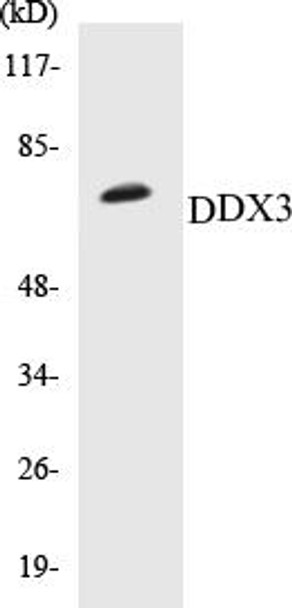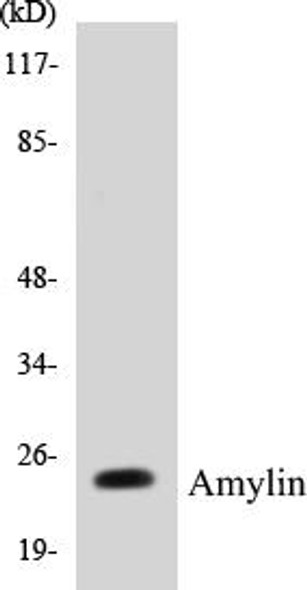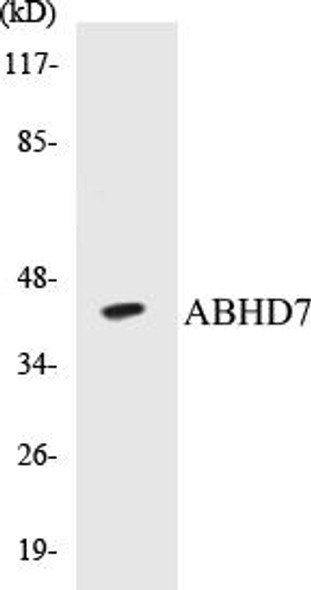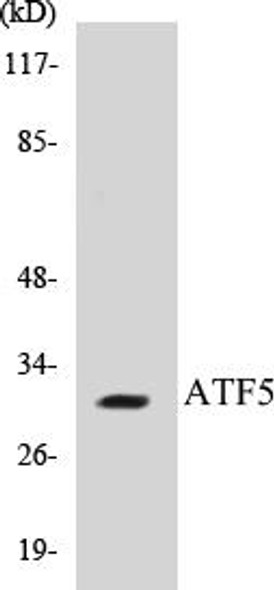Description
DDX3 Colorimetric Cell-Based ELISA Kit
The DDX3 Colorimetric Cell-Based ELISA Kit from Assay Genie is specifically designed for the accurate and efficient detection of DDX3 protein levels in cell cultures. This kit offers high sensitivity and specificity, providing reliable and reproducible results for a variety of research applications.DDX3 is a vital protein involved in RNA metabolism and cell signaling pathways, playing a crucial role in cancer progression, viral infections, and neurological disorders.
By accurately measuring DDX3 levels in cell culture supernatants, researchers can gain valuable insights into the mechanisms underlying these conditions and potentially identify new therapeutic targets.Overall, the DDX3 Colorimetric Cell-Based ELISA Kit is an essential tool for studying DDX3 protein expression and function in cell cultures, offering researchers a reliable way to investigate its role in disease pathogenesis and therapeutic development.
| Product Name: | DDX3 Colorimetric Cell-Based ELISA Kit |
| Product Code: | CBCAB00622 |
| ELISA Type: | Cell-Based |
| Target: | DDX3 |
| Reactivity: | Human, Mouse, Rat |
| Dynamic Range: | > 5000 Cells |
| Detection Method: | Colorimetric 450 nmStorage/Stability:4°C/6 Months |
| Format: | 96-Well Microplate |
The DDX3 Colorimetric Cell-Based ELISA Kit is a convenient, lysate-free, high throughput and sensitive assay kit that can detect DDX3 protein expression profile in cells. The kit can be used for measuring the relative amounts of DDX3 in cultured cells as well as screening for the effects that various treatments, inhibitors (ie siRNA or chemicals), or activators have on DDX3.
Qualitative determination of DDX3 concentration is achieved by an indirect ELISA format. In essence, DDX3 is captured by DDX3-specific primary antibodies while the HRP-conjugated secondary antibodies bind the Fc region of the primary antibody. Through this binding, the HRP enzyme conjugated to the secondary antibody can catalyze a colorimetric reaction upon substrate addition. Due to the qualitative nature of the Cell-Based ELISA, multiple normalization methods are needed:
| 1. | A monoclonal antibody specific for human GAPDH is included to serve as an internal positive control in normalizing the target absorbance values. |
| 2. | Following the colorimetric measurement of HRP activity via substrate addition, the Crystal Violet whole-cell staining method may be used to determine cell density. After staining, the results can be analysed by normalizing the absorbance values to cell amounts, by which the plating difference can be adjusted. |
| Database Information: | Gene ID: 1654, UniProt ID: O00571/O15523, OMIM: 300160, Unigene: Hs.380774 |
| Gene Symbol: | DDX3X |
| Sub Type: | None |
| UniProt Protein Function: | DDX3: a multifunctional DEAD box family RNA helicase with diverse cellular functions. DEAD box proteins are characterized by the conserved motif Asp-Glu-Ala-Asp (DEAD), and are involved in several steps of gene expression, such as transcription, maturation of nuclear and mitochondrial mRNA, mRNA export, translation initiation, and ribosome and spliceosome assembly. DDX3 is required for nuclear export of HIV-1 viral transcripts, possibly in a complex with the viral Rev protein and host cofactor CRM1. DDX3 is required for hepatitis C virus (HCV) RNA replication and its expression is downregulated in hepatitis B virus (HBV) associated hepatocellular carcinoma (HCC). May function as a tumor suppressor protein. Its expression inhibits tumor cell colony formation and increases expression of the cdk inhibitor p21 Waf1/Cip1. Low DDX3 expression has been shown in HCC, and aberrant subcellular localization occurs in many squamous cell carcinomas. Reduced DDX3 expression in cultured cells causes a diminished dependence on serum for cell proliferation and changes in cyclin D1 and p21 Waf1/Cip1 expression. Associates with eIF4F to promote translation of selected mRNAs. Is phosphorylated by the mitotic cyclin dependent kinase, cyclin B/cdc2. This phosphorylation may cause a loss of DDX3 function and a concomitant repression of ribosome biogenesis and translation in mitosis. Involved in TBK1 and IKBKE-dependent IRF3 activation leading to IFN-beta induction. Involved in regulation of apoptosis. May be required for activation of the intrinsic but inhibit activation of the extrinsic apoptotic pathway. Regulated by the cell cycle. Maximally expressed in the cytoplasm during G1/S phase and decreased expression during G2/M phase. Located predominantly in nuclear speckles and, at low levels, throughout the cytoplasm. Associates with the outer side of nuclear pore complexes (NPC) and mitochondrial outer membranes. Shuttles between the nucleus and the cytoplasm in an exportin1-dependent manner. Associates with polyadenylated mRNAs in the cytoplasm and the nucleus. Predominantly located in nucleus during G0 phase and in the cytoplasm during G1/S phase. Belongs to the DEAD box helicase family, DDX3 subfamily. Two isoforms of the human protein are produced by alternative splicing. |
| UniProt Protein Details: | Protein type:Spliceosome; Helicase; RNA-binding; Translation initiation; EC 3.6.4.13; Cell cycle regulation Chromosomal Location of Human Ortholog: Xp11.3-p11.23 Cellular Component: eukaryotic translation initiation factor 3 complex; mitochondrial outer membrane; stress granule; cytoplasm; nuclear speck; nucleus Molecular Function:GTPase activity; CTPase activity; RNA binding; ATPase activity; transcription factor binding; poly(A) binding; ATP-dependent DNA helicase activity; protein binding; DNA binding; translation initiation factor binding; nucleoside-triphosphatase activity; eukaryotic initiation factor 4E binding; mRNA 5'-UTR binding; ATP-dependent RNA helicase activity; ribosomal small subunit binding; ATP binding Biological Process: stress granule assembly; positive regulation of viral genome replication; viral reproduction; positive regulation of translation; transcription, DNA-dependent; positive regulation of apoptosis; response to virus; positive regulation of caspase activity; negative regulation of caspase activity; positive regulation of cell growth; DNA duplex unwinding; chromosome segregation; positive regulation of translational initiation; induction of apoptosis via death domain receptors; negative regulation of translation; RNA secondary structure unwinding; positive regulation of interferon-beta production; innate immune response; positive regulation of transcription from RNA polymerase II promoter; negative regulation of cell growth; negative regulation of protein complex assembly; mature ribosome assembly; negative regulation of apoptosis Disease: Mental Retardation, X-linked 102 |
| NCBI Summary: | The protein encoded by this gene is a member of the large DEAD-box protein family, that is defined by the presence of the conserved Asp-Glu-Ala-Asp (DEAD) motif, and has ATP-dependent RNA helicase activity. This protein has been reported to display a high level of RNA-independent ATPase activity, and unlike most DEAD-box helicases, the ATPase activity is thought to be stimulated by both RNA and DNA. This protein has multiple conserved domains and is thought to play roles in both the nucleus and cytoplasm. Nuclear roles include transcriptional regulation, mRNP assembly, pre-mRNA splicing, and mRNA export. In the cytoplasm, this protein is thought to be involved in translation, cellular signaling, and viral replication. Misregulation of this gene has been implicated in tumorigenesis. This gene has a paralog located in the nonrecombining region of the Y chromosome. Pseudogenes sharing similarity to both this gene and the DDX3Y paralog are found on chromosome 4 and the X chromosome. Alternative splicing results in multiple transcript variants. [provided by RefSeq, Oct 2014] |
| UniProt Code: | O00571 |
| NCBI GenInfo Identifier: | 3023628 |
| NCBI Gene ID: | 1654 |
| NCBI Accession: | O00571.3 |
| UniProt Secondary Accession: | O00571,O15536, A8K538, B4E3E8, |
| UniProt Related Accession: | O00571 |
| Molecular Weight: | Calculated: 71kDa/73kDaObserved: 80kDa |
| NCBI Full Name: | ATP-dependent RNA helicase DDX3X |
| NCBI Synonym Full Names: | DEAD (Asp-Glu-Ala-Asp) box helicase 3, X-linked |
| NCBI Official Symbol: | DDX3X |
| NCBI Official Synonym Symbols: | DBX; DDX3; HLP2; DDX14; CAP-Rf |
| NCBI Protein Information: | ATP-dependent RNA helicase DDX3X; DEAD/H box-3; DEAD box, X isoform; helicase-like protein 2; DEAD box protein 3, X-chromosomal; DEAD/H (Asp-Glu-Ala-Asp/His) box polypeptide 3; DEAD (Asp-Glu-Ala-Asp) box polypeptide 3, X-linked |
| UniProt Protein Name: | ATP-dependent RNA helicase DDX3X |
| UniProt Synonym Protein Names: | DEAD box protein 3, X-chromosomal; DEAD box, X isoform; Helicase-like protein 2; HLP2 |
| Protein Family: | ATP-dependent RNA helicase |
| UniProt Gene Name: | DDX3X |
| UniProt Entry Name: | DDX3X_HUMAN |
| Component | Quantity |
| 96-Well Cell Culture Clear-Bottom Microplate | 2 plates |
| 10X TBS | 24 mL |
| Quenching Buffer | 24 mL |
| Blocking Buffer | 50 mL |
| 15X Wash Buffer | 50 mL |
| Primary Antibody Diluent | 12 mL |
| 100x Anti-Phospho Target Antibody | 60 µL |
| 100x Anti-Target Antibody | 60 µL |
| Anti-GAPDH Antibody | 60 µL |
| HRP-Conjugated Anti-Rabbit IgG Antibody | 12 mL |
| HRP-Conjugated Anti-Mouse IgG Antibody | 12 mL |
| SDS Solution | 12 mL |
| Stop Solution | 24 mL |
| Ready-to-Use Substrate | 12 mL |
| Crystal Violet Solution | 12 mL |
| Adhesive Plate Seals | 2 seals |
The following materials and/or equipment are NOT provided in this kit but are necessary to successfully conduct the experiment:
- Microplate reader able to measure absorbance at 450 nm and/or 595 nm for Crystal Violet Cell Staining (Optional)
- Micropipettes with capability of measuring volumes ranging from 1 µL to 1 ml
- 37% formaldehyde (Sigma Cat# F-8775) or formaldehyde from other sources
- Squirt bottle, manifold dispenser, multichannel pipette reservoir or automated microplate washer
- Graph paper or computer software capable of generating or displaying logarithmic functions
- Absorbent papers or vacuum aspirator
- Test tubes or microfuge tubes capable of storing ≥1 ml
- Poly-L-Lysine (Sigma Cat# P4832 for suspension cells)
- Orbital shaker (optional)
- Deionized or sterile water
*Note: Protocols are specific to each batch/lot. For the correct instructions please follow the protocol included in your kit.
| Step | Procedure |
| 1. | Seed 200 µL of 20,000 adherent cells in culture medium in each well of a 96-well plate. The plates included in the kit are sterile and treated for cell culture. For suspension cells and loosely attached cells, coat the plates with 100 µL of 10 µg/ml Poly-L-Lysine (not included) to each well of a 96-well plate for 30 minutes at 37°C prior to adding cells. |
| 2. | Incubate the cells for overnight at 37°C, 5% CO2. |
| 3. | Treat the cells as desired. |
| 4. | Remove the cell culture medium and rinse with 200 µL of 1x TBS, twice. |
| 5. | Fix the cells by incubating with 100 µL of Fixing Solution for 20 minutes at room temperature. The 4% formaldehyde is used for adherent cells and 8% formaldehyde is used for suspension cells and loosely attached cells. |
| 6. | Remove the Fixing Solution and wash the plate 3 times with 200 µL 1x Wash Buffer for five minutes each time with gentle shaking on the orbital shaker. The plate can be stored at 4°C for a week. |
| 7. | Add 100 µL of Quenching Buffer and incubate for 20 minutes at room temperature. |
| 8. | Wash the plate 3 times with 1x Wash Buffer for 5 minutes each time. |
| 9. | Add 200 µL of Blocking Buffer and incubate for 1 hour at room temperature. |
| 10. | Wash 3 times with 200 µL of 1x Wash Buffer for 5 minutes each time. |
| 11. | Add 50 µL of 1x primary antibodies (Anti-DDX3 Antibody and/or Anti-GAPDH Antibody) to the corresponding wells, cover with Parafilm and incubate for 16 hours (overnight) at 4°C. If the target expression is known to be high, incubate for 2 hours at room temperature. |
| 12. | Wash 3 times with 200 µL of 1x Wash Buffer for 5 minutes each time. |
| 13. | Add 50 µL of 1x secondary antibodies (HRP-Conjugated AntiRabbit IgG Antibody or HRP-Conjugated Anti-Mouse IgG Antibody) to corresponding wells and incubate for 1.5 hours at room temperature. |
| 14. | Wash 3 times with 200 µL of 1x Wash Buffer for 5 minutes each time. |
| 15. | Add 50 µL of Ready-to-Use Substrate to each well and incubate for 30 minutes at room temperature in the dark. |
| 16. | Add 50 µL of Stop Solution to each well and read OD at 450 nm immediately using the microplate reader. |
(Additional Crystal Violet staining may be performed if desired – details of this may be found in the kit technical manual.)






